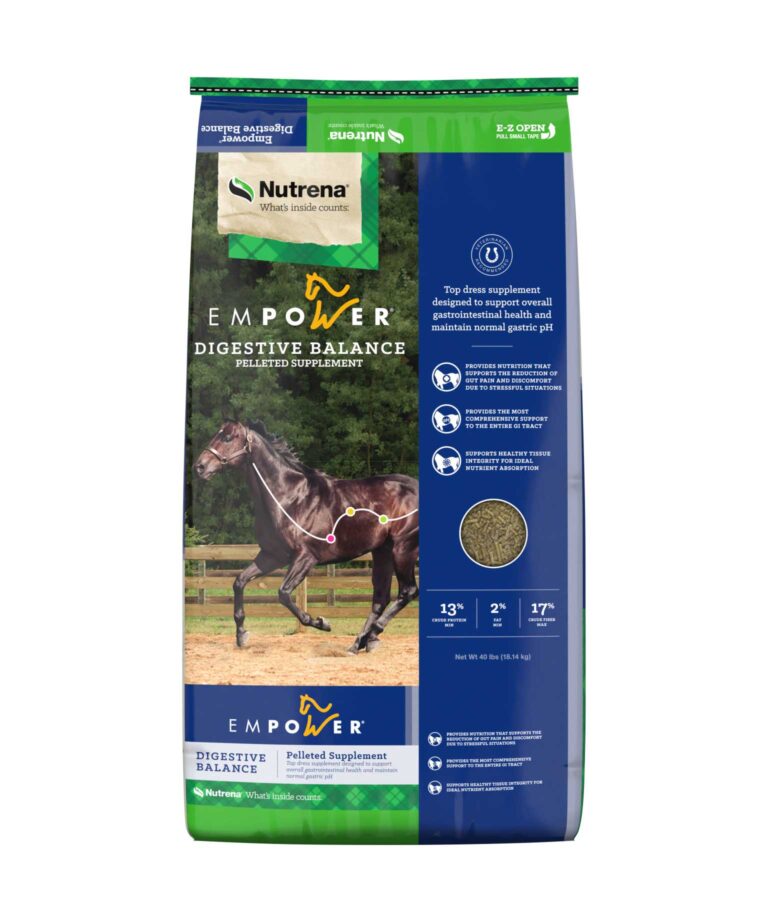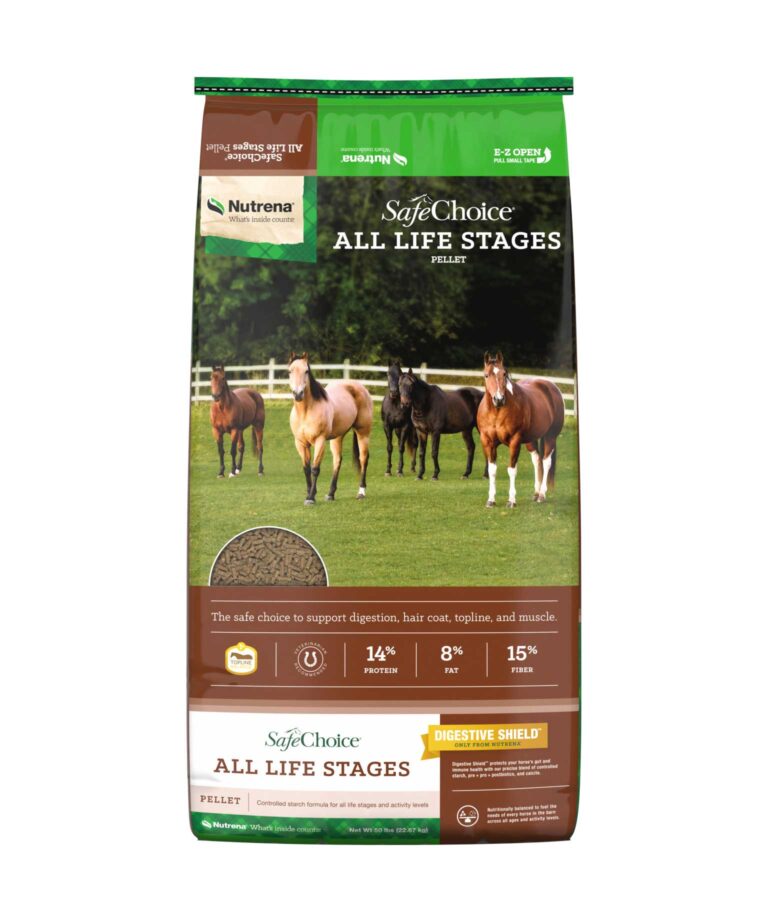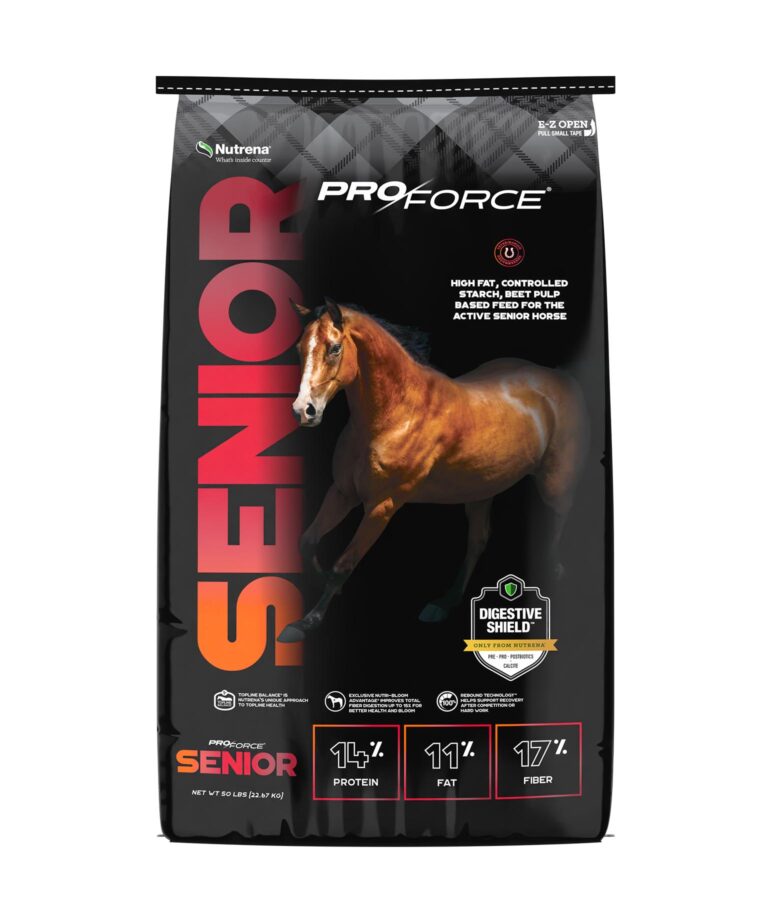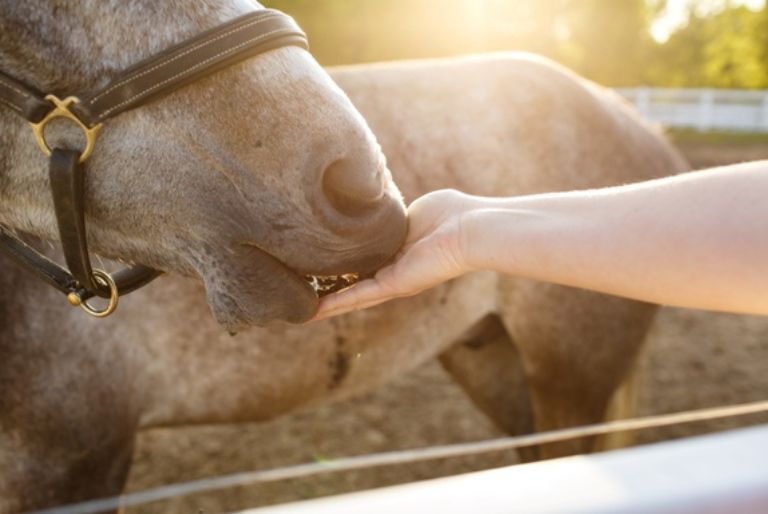Horse Feed for Gut Health and Digestion Support
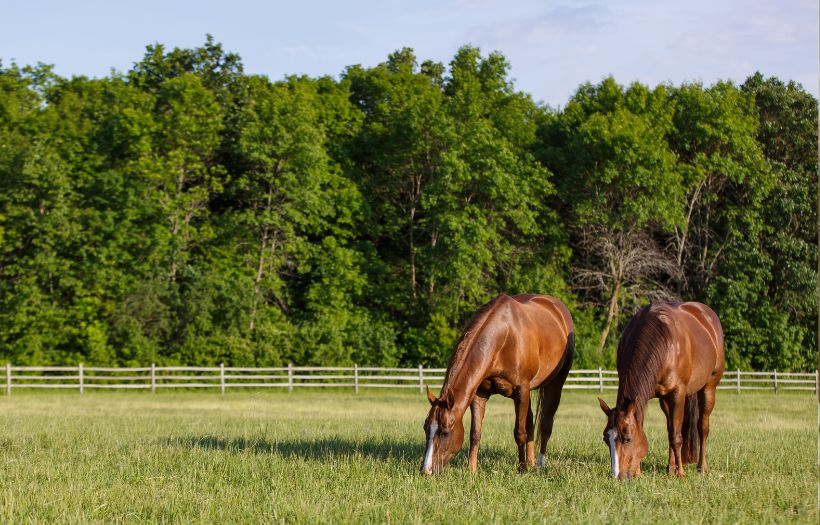
What is the best horse feed for digestion? Why is feeding for gastric support important? What ingredients on your feed tags promote stomach, foregut, and hindgut health? Our equine nutritionists at Nutrena® break down some of these most frequently asked questions about how to choose horse feed for gut health, so you can feel confident that you are supporting your horse’s entire digestive tract regardless of life stage and activity level. Because here at Nutrena, we believe What’s Inside Counts®.
Table of Contents
Key Takeaways
- Signs your horse needs gastric support include poor body condition, colic, and behavioral changes.
- A balanced diet for horses should include controlled starch and sugar, easily digestible fiber, and pre/probiotics.
- Nutrena offers special formulations, like Digestive Shield™, that combine pre, pro, and postbiotics for gut health support.
- Always consult your veterinarian for specific dietary recommendations based on your horse’s health needs.
What are the Signs that your Horse needs Gastric Support?
The digestive tract, or “gut,” of the horse is responsible for breaking down and absorbing nutrients and is estimated to contain 70% of the horse’s immune system. So, when the gastrointestinal tract or the microbial population is off balance, it can affect the overall health of the horse. Visually, you may be able to see signs that your horse’s gut health is off balance through poor body condition, frequent colic, diarrhea, or a suppressed immune system. You may also see behavioral signs your horse needs gastric support if your horse is “cinchy” or reactive to being saddled, resistant to being touched/brushed, is having behavioral problems under saddle, or unwilling to eat (particularly concentrates). These are all signs that your horse may need some support for their gut health.
Please note that every horse is different, so it is always important to consult your veterinarian when questioning if your horse is experiencing poor gut health. For nutritional guidance, you can also schedule a virtual consultation, and one of our equine nutritionists can help you choose the best horse feed for gut health.
Diet Recommendations for Digestive Support
Whether you have a growing horse, broodmare, senior horse, performance horse, or anything in between, it is necessary their diet supports the entire digestive tract from foregut to hindgut health. Some of the main diet recommendations for digestive support are:
- Controlled Starch and Sugar: You can find diets with moderate or low starch and sugar levels – both beneficial for different types of horses. The key is checking your feed tags for “guaranteed” maximum starch and sugar levels. This is much more common for feed companies to include on tags today, but before Nutrena introduced the SafeChoice® line over 20 years ago as the first-ever controlled starch horse feed, starch and sugar content was often unknown. Nutrena® offers feeds with a range of maximum Non-Structural Carbohydrates (NSC), like SafeChoice® Special Care at only 10% NSC or performance horse feeds like ProForce® Fuel at 20% NSC for adequate energy. When your feed has controlled NSC levels, you can confidently choose the best feed for your horse’s dietary requirements.
- Easily Digestible Fiber: Easily digestible fiber helps efficiently extract nutrients and avoid stressing the digestive system, especially for senior horses. So, in addition to buying grain that guarantees controlled starch and sugar, look for ingredients that improve digestive efficiency also. For example, Nutrena ProForce® feeds and SafeChoice® feeds include Nutri-Bloom Advantage® which was tested in a digestibility trial and saw up to 15% more fiber digestion. This will help to support stress on your horse’s gut.
- Prebiotics: These are the nutrients that beneficial bacteria eat – in other words, “the fuel” for the “good bugs.” Prebiotics help stabilize the population of microorganisms when, for example, there are sudden changes in a horse’s diet, which helps to reduce digestive upset. They can stimulate the growth and activity of beneficial microorganisms, which benefit the horse by enhancing the absorption and retention of certain nutrients. Promoting “good” micro-organisms can also help keep populations of less desirable microbes in check, a concept known as competitive exclusion.
- Probiotics: These are living microorganisms — “the factories” — that can be added to a horse’s diet to help balance its gut flora population. Providing more beneficial bacteria can increase nutrient digestibility and shift the balance of microbes in a positive way. Probiotics can be measured on a feed tag by the measure of Colony Forming Units (CFU) per pound of feed declared on the tag. In general, the higher the CFU/lb. level, the better, if you are comparing similar strains and products of equal stability.
- Postbiotics: A postbiotic is the combination of inanimate microorganisms, both intact and cell wall fragments/structures, and their metabolites that when fed back to an animal confer a health benefit. Postbiotics are often considered “the goods” if the microorganisms themselves are “the factories”. While microorganisms within the animal certainly produce “goods” in the form of volatile fatty acids (an energy source), vitamins, and more, fermentation of yeast and bacteria outside the animal creates a unique profile of metabolites. These metabolites when consumed in the feed as Postbiotics then serve as signaling molecules for a variety of physiologic functions including enhanced immune response. The signaling molecules can also support other microbes to further stabilize the microbiome.
- Calcite: In addition to pre + pro + postbiotics supporting optimal immune health, aiding in the digestion process, and providing a buffer against bad bacteria, another key ingredient to look is Calcite. Calcium in the diet is a natural buffering agent; however, studies have shown that a marine-derived calcium, known as Calcite, has up to 2x greater buffering capacity when compared to calcium carbonate normally used in horse feeds.¹ Calcite’s greater buffering capacity can be attributed to its more porous surface area. Not only that, but research has also shown a beneficial buffering effect of Calcite in the horse’s hindgut (cecum and large intestine).¹ In times of extreme stress or illness, the horse’s hindgut can experience a rapid decline in pH, known as acidosis. This acidic environment can be damaging to the microbial population, cause inflammation in the gut, and initiate a cascade of damaging effects for the horse. Helping to buffer or maintain hindgut pH, then, can help keep the horse’s hindgut functioning normally.
While many feeds have prebiotics or probiotics, Nutrena SafeChoice® feeds and Nutrena ProForce® feeds are the first to offer Digestive Shield™, with a blend of pre + pro + postbiotics and calcite.
Find Horse Feed for Gut Health Near You
Nutrena offers a few different feed and balancer options depending on your horse’s digestive needs.
References: Moore-Colyer, M. D. M. O’Gorman, K. Wakefield. An In Vitro investigation into the effects of a marine-derived, multimineral supplement in simulated equine stomach and hindgut environments. J. of Eq. Vet. Sci. 34 (2014): 391–397.

